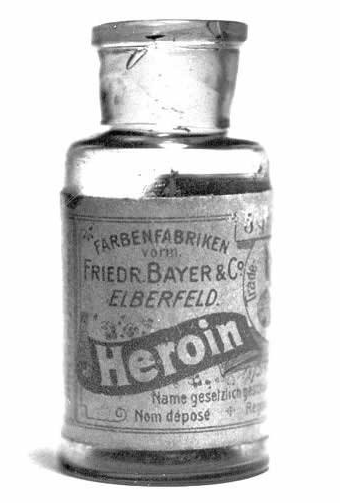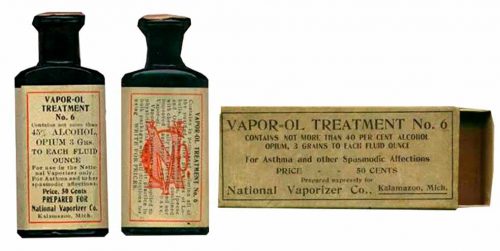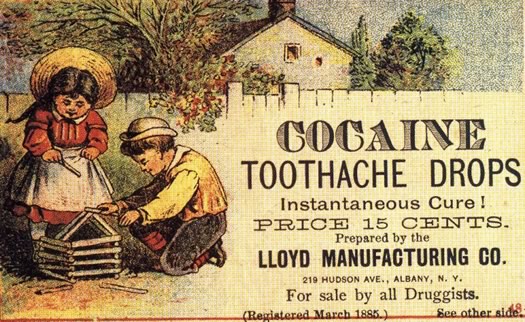Flashback Friday.
My great-grandma would put a few drops of turpentine on a sugar cube as a cure-all for any type of cough or respiratory ailment. Nobody in the family ever had any obvious negative effects from it as far as I know. And once when I had a sinus infection my grandma suggested that I try gargling kerosene. I decided to go to the doctor for antibiotics instead, but most of my relatives thought that was a perfectly legitimate suggestion.
In the not-so-recent history, lots of substances we consider unhealthy today were marketed and sold for their supposed health benefits. Joe A. of Human Rights Watch sent in these images of vintage products that openly advertised that they contained cocaine or heroin. Perhaps you would like some Bayer Heroin?
Flickr Creative Commons, dog 97209
The Vapor-ol alcohol and opium concoction was for treating asthma:
Cocaine drops for the kids:
A reader named Louise sent in a recipe from her great-grandma’s cookbook. Her great-grandmother was a cook at a country house in England. The recipe is dated 1891 and calls for “tincture of opium”. The recipe (with original spellings):
Hethys recipe for cough mixture
1 pennyworth of each
Antimonial Wine
Acetic Acid
Tincture of opium
Oil of aniseed
Essence of peppermint
1/2lb best treacleWell mix and make up to Pint with water.
As Joe says, it’s no secret that products with cocaine, marijuana, opium, and other now-banned substances were at one time sold openly, often as medicines. The changes in attitudes toward these products, from entirely acceptable and even beneficial to inherently harmful and addicting, is a great example of social construction. While certainly opium and cocaine have negative effects on some people, so do other substances that remained legal (or were re-legalized, in the case of alcohol).
Often racist and anti-immigrant sentiment played a role in changing views of what are now illegal controlled substances; for instance, the association of opium with Chinese immigrants contributed to increasingly negative attitudes toward it as anything associated with Chinese immigrants was stigmatized, particularly in the western U.S. This combined with a push by social reformers to prohibit a variety of substances, leading to the Harrison Narcotic Act. The act, passed in 1914, regulated production and distribution of opium but, in its application, eventually basically criminalized it.
Reformers pushing for cocaine to be banned suggested that its effects led Black men to rape White women, and that it gave them nearly super-human strength that allowed them to kill Whites more effectively. A similar argument was made about Mexicans and marijuana:
A Texas police captain summed up the problem: under marijuana, Mexicans became “very violent, especially when they become angry and will attack an officer even if a gun is drawn on him. They seem to have no fear, I have also noted that under the influence of this weed they have enormous strength and that it will take several men to handle one man while under ordinary circumstances one man could handle him with ease.”
So the story of the criminalization of some substances in the U.S. is inextricably tied to various waves of anti-immigrant and racist sentiment. Some of the same discourse–the “super criminal” who is impervious to pain and therefore especially violent and dangerous, the addicted mother who harms and even abandons her child to prostitute herself as a way to get drugs–resurfaced as crack cocaine emerged in the 1980s and was perceived as the drug of choice of African Americans.
Originally posted in 2010.
Gwen Sharp is an associate professor of sociology at Nevada State College. You can follow her on Twitter at @gwensharpnv.



Comments 44
Deaf Indian Muslim Anarchist — February 22, 2010
Great post. yep the Drug War was born out of racism.
The U.S government needs to quit its bitching and legalize maurijana and cocaine already. I'm not sure about opium and heroin, though? Would love to hear others' input here.
Anonnymouse — February 22, 2010
I think that when they say marijuana, they mean PCP, and when they say Mexicans, they mean everyone.
Kate — February 22, 2010
I think the opium bits are especially interesting. Opiates are very safe at the sorts of doses they are suggesting and in infants far safer than NSAISs. Our paranoia about anyone abusing them does deprive people of a very useful medicine. I was amazed during my anaesthesia training the extent to which sensible use of opiates was the safest option, particularly in weaker patients.
April — February 22, 2010
Cocaine and its derivatives are still used medically--cocaine straight up for nasal surgery (especially on children) and its derivatives as painkillers--such as novocaine.
Also, methamphetamine was sold over the counter as an inhaler for asthma until....the fifties I think? And it was prescription for the same purpose for a few years after that.
Village Idiot — February 22, 2010
Opium is still a vital medicine for millions, saving the lives of countless children every year (and you can order it on eBay, lol). Opium causes constipation, and that's a good thing when the top killer of children is diarrhea (works for adults too, but it's kind of an ironic twist on the old "what about the children?!?" argument for prohibition). Coca (NOT cocaine) is a complete food, containing all essential vitamins and minerals necessary to survive, and a very important effect from chewing coca leaves is a boost of the brain's ability to absorb oxygen, allowing Andean natives to live and engage in strenuous work at very high altitudes. When the Keystone Cops (DEA) spray poppy or coca fields, they're also attacking the cultures that grow them as if it's the local's fault that people thousands of miles away want to get wasted on chemically-potentiated extracts of their traditional botanical medicines.
More irony (or is it hypocrisy?): Cocaine is Schedule II in the U.S., meaning it has accepted medical value whereas cannabis is still Schedule I, meaning it has no known medical value and a high potential for abuse. Yet no one gets a prescription for cocaine (as far as I know of) and it's highly addictive plus potentially lethal but cannabis prescriptions are becoming widespread and it's not physically addictive nor can anyone die from overdosing on it. Same goes for the hallucinogens (all still Schedule I) even though UCLA Medical Center is reporting very promising results in its studies of psilocybin and salvinorin A.
Methamphetamine is also Schedule II, and is available by prescription under the name Desoxyn. It's prescribed when the side effects of Adderall are too severe since methamphetamine is less toxic and has fewer side effects than Adderall (or coffee for that matter), but they don't tell you that on those stupid "faces of meth" billboards. Incidentally, what you're seeing on those are in reality the "faces of chronically overdosing on meth contaminated by heavy metals and industrial solvents due to improper synthesis using industrial-grade chemicals (not pharmaceutical grade). That's why those faces didn't start popping up until the government took away the easy access to precursors such as ephedrine (which is pharmaceutical-grade when purchased over the counter) yet it's been widely used in the U.S. since the 1950's.
Anyway, a single sub-threshold dose of psilocybin has been reported to prevent cluster headaches for up to six months in those who suffer from them, and salvinorin A is being studied as a treatment for depression (as is psilocybin also, along with it's potential for therapeutic use among the terminally ill). DMT is an endogenous molecule, yet it too is Schedule I even though it's completely non-toxic and non-addictive (technically we're all "in possession" of DMT as it's synthesized in our brains). Oh, and cannabis has been found to have a chemoprotective effect against lung cancer (yet tobacco is legal?), and then there's this fascinating study: Cannabinoids promote embryonic and adult hippocampus neurogenesis and produce anxiolytic- and antidepressant-like effects
Link: http://www.jci.org/articles/view/25509/pdf
Then again, legalizing drugs would cripple the private prison industry, and that would be... great! (and well-deserved)
Quando l’eroina era un prodotto da banco « Hyde Pank — February 23, 2010
[...] età: 5 gocce per i bimbi di 5 giorni, 8 per quelli di due settimane. Altre immagini da vedere su sociological images Tag: cocaina, eroina, farmacia, oppio, sociological images Condividi questo [...]
John Yum — February 23, 2010
This is cruelly ironic, since it was the British who forced opium upon the Chinese, leading to the first Opium War (the fallout of which led to the second Opium War). However, since China lost both of these wars, Britain was able to literally force opium upon the Chinese and place it firmly in the mainstream of Chinese life. When Chinese migrant workers started arriving to the US, Chinese opium dens were an unfortunate part of "Chinese" culture (with no recognition of the fundamental role the British played in the whole thing), and this ironic twist of history remains until today.
Beelzebub — February 23, 2010
Addiction to nicotine was unheard of before Europeans got their hands on it. Addiction to opium was unheard of before Europeans got their hands on it. I wonder why that might be.
What will be socially acceptable 100 years from now? — February 24, 2010
[...] to Sociological Images for an eye-opening display of vintage ads for cocaine and opium [...]
Gina — February 24, 2010
Paregoric was sold in the U.S. as late as the early 1970s--I was given it for severe "growing pains" in 1971. Extremely effective painkiller of course, but my mother discontinued use after deciding to try it and experiencing wildly disturbing dreams.
Liquid cocaine was used as a topical anesthetic as late as 1980 - my spouse had it applied before a sinus procedure. I'd guess it is probably still used for this, accounting for the Schedule II listing.
Village Idiot — February 24, 2010
By the way: The pharmaceutical chemists at Bayer invented heroin, and one of the benefits they originally claimed was that it was a cure for morphine addiction. It worked spectacularly well in that regard, except now how to you cure the heroin addiction? Methadone! Methadone addiction is not significantly different from heroin addiction except the State is the dealer and the chemical leash is shorter (addicts can go longer between fixes with heroin than with methadone).
The only genuine, sustainable pharmaceutical cure for heroin addiction is ibogaine, which also cures addictive behavior in general for a large percentage of those who use it therapeutically. Oddly enough, it was banned long before almost anyone heard of it, so I think the pharmaceutical companies discovered it and decided they didn't like how well it worked. Still, there are underground clinics in NYC and other cities (plus legal ones in Mexico) that are staffed by doctors and last time I checked charge about $1500 for several days of treatment for heroin and cocaine addicts (compare that to the cost of conventional rehab that rarely works).
Ibogaine works best for opiates because it fits into the same receptor sites and so the addict kicks the habit without going through the hideous withdrawal symptoms normally associated with that class of drugs (although they will be laying on the floor tripping for a few days since it's a psychedelic sedative, but that part is integral to the treatment since addiction is in our head). William S. Burroughs wrote of something called "apo-morphine" that supposedly cures opiate addiction, but I haven't heard anything else about it and so I don't know if there's anything to it.
As bad as kicking opiate addiction is, it won't kill someone. The only drugs that have withdrawal symptoms sufficiently severe to kill someone trying to quit cold-turkey are alcohol, Valium, and Xanax (and possibly other benzodiazepines). Incidentally, they all work by inhibiting brain function in various ways.
Verlinkenswertes (KW 08/10) | Criminologia — February 28, 2010
[...] Vintage Ads for Cocaine and Opium Products (Sociological Images, 22.02.2010) AKPC_IDS += "3410,"; Artikel weiterempfehlen: [...]
Sociological Images Update (Feb. 2010) » Sociological Images — March 1, 2010
[...] our post on vintage products containing opium and cocaine? Louise sent us a photo of a hand-written recipe from her great-grandmother’s cookbook that [...]
Beth Morgan — March 2, 2010
Bayer didn't just advertise a product containing heroin-- they created the product and gave it its name.
http://en.wikipedia.org/wiki/Heroin#Etymology
Nick — March 21, 2010
"...turpentine on a sugar cube as a cure-all for any type of cough or respiratory ailment. Nobody in the family ever had any obvious negative effects from it as far as I know."
And until the 60's no one in my family ever used a seatbelt... and no one had any obvious negative side effects from not using them.
Or to quote Roger Brinner: The plural of anecdote is 'Not data'.
Nick — March 21, 2010
"remedy didn’t have any obvious negative consequences, so it makes sense that people continue to try it."
But it really makes sense only if you assume that relying on anecdotal data that illustrates humans' dearth of natural abilities at statistical analyses is 'good sense'.
As a species we're sucktastic at accuracy in pattern recognition. From an evolutionary perspective, false positives (thinking the sound you heard was a predator rather than the wind rustling in the trees that it actually was) are favored over false negatives (thinking its the wind when its really a predator.) So we see false patterns smashingly well. This is the reason that remedies like kerosene on a sugar cube are suggested... because most of the time when you do that, people get better. And we preferentially remember the times it worked over the times where it didn't.
So its like using Galen's description of a remedy he proffered: "All who drink of this remedy recover in a short time, except those whom it does not help, who all die. Therefore, it is obvious that it fails only in incurable cases."
The point is that just because you haven't seen someone harmed by a treatment, that doesn't mean its safe and just because a person got better after a treatment that doesn't mean its effective. In context of the OP's full post I would then suggest that a logical drug policy would be to study the repercussions of decriminalizing (and/or legalizing) each drug rather than just saying: it was criminalize for a bad reason, lets make it free at every corner grocery.
classicViralVids — October 12, 2010
i need some cocaine tooth aches drops right now!!
Will Convery — December 22, 2012
Its not a war on drugs, its a war on kids
Al_de_Baran — February 18, 2014
"Often racist and anti-immigrant sentiment played a role in changing views of what are now illegal controlled substances"
Yes, and that's quote a scholarly and objective source you cite to support your opinion, too, Gwen Sharp, Ph.D.
Political correctness and victimology aside, the main reason why opium began to obtain a negative reputation is because its negative effects were increasingly recognized. Sorry if that inconvenient fact fails to fit your victimhood narrative.
ivy michael — July 18, 2024
Examining the criminalization of opium and marijuana reveals how racial biases have influenced drug policy historically. Laws adult night care services Long Beach often targeted marginalized communities, using fear to justify harsher penalties. Understanding this context is crucial for addressing systemic inequalities in current drug enforcement and fostering more equitable legal reforms.